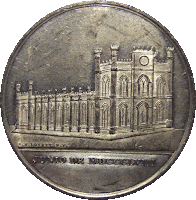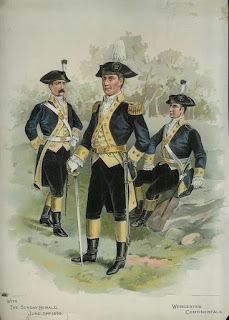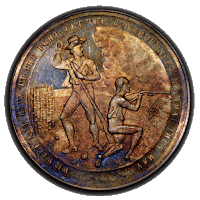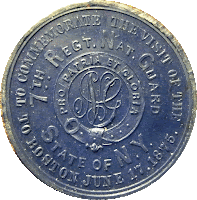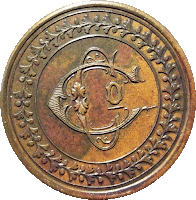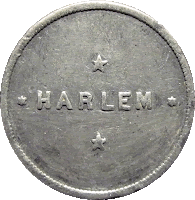MISCELLANEOUS PLACES AND EVENTS
Havana to Matanzas Railway Inauguration
White metal, 51.1mm
|
|
|
United States Medallion Company Centennial Medals - George H.
The U.S. Medallion Co. of New York produced several varieties of medals
celebrating the 1876 Centennial of American Independence. At least one die,
the obverse of HK-80 for the Grand Entrance International, was engraved
by George H. Lovett as evidenced by the small "G.H.L." to the right
just above the exergue line. No other dies are signed but two do contain
lettering very similar to that used by George H. on other works. I am
including all the varieties here as possibly his work.
Grand Entrance International, HK 80, white metal, 43mm
Grand Entrance International - obverse of GW-822, white metal, 42mm
(image courtesy of Jonathan Brecher)
GW-822, Baker 406, silver, 42mm
IMAGE NEEDED
GW-822, Baker 406A, white metal, 42mm
(image courtesy of Stacks Bowers)
GW-822, unlisted variety, white metal, 42mm
(image courtesy of Stacks Bowers)
Worcester Continentals Medals
White metal, Ma-Wc 35, Storer 1827, 40mm
"Worcester Continentals Fair" reverse
Bronze, 39.9mm, "Worcester Continentals Fair" reverse
Brass - uniface, unlisted, 40mm
Brass? (possibly bronzed) - uniface with pin, unlisted, 39.87mm
|
|
The
example above with the "Worcester Continentals Fair" reverse is listed
in The Standard Catalog of U.S Tokens and Storer's Numismatics of
Massachusetts but only in white metal. It is obvious by the signature
that George H. did produce the reverse design but did he also do the
obverse? Were the uniface medals produced first for members to wear and
later George H. combined this with his die to produce the piece
celebrating the 1880 Fair? Or did he produce both dies and the medal for
the Fair, later striking the uniface examples to be used with the pins?
Anyone with any information on this please contact me.
|
Battle of Groton Heights Centennial Medal
HK 125, white metal, 40mm
HK 125b, bronze, 40mm
HK 125c, silver, 40mm
(on line image)
Armory Seventh Regiment Medals
Silver, 39.8mm
Bronze, 39.9mm
Brass, 40mm
White metal, 40mm
City of New York Airship
From the Smithsonian's Air and Space Museum website
"Token sold or given as souvenir to those visiting the balloon originally known as the "City of New York," later renamed the "Great Western." Constructed by T.S.C. Lowe in 1859, the balloon stood 200 feet tall from the keel of the lifeboat dangling beneath the basket to this valve at the very top of the envelope. The envelope was 130' in diameter, with a total capacity of 725.000 cubic feet of lifting gas. Work on the balloon began in July 1859, and was complete within 90 days. Inflation began at the New York City Crystal Palace, 42nd St. and 6th Avenue, on September 30, 1859. By November 16, Lowe was forced to apologize for the fact that inflation was still far from complete. The New York City gas system was apparently not equal to the task. Lowe renamed the balloon "Great Western" that fall, in response to the gigantic transatlantic steamer "Great Eastern," and placed it in storage. He accepted an offer from citizens of Philadelphia to host the inflation and flight of the balloon the following spring. The "Great Western" took to the air for the first time from Philadelphia in late June 1860. The controversial balloon burst during inflation on September 8, 1860. Attempts to fund the repair of the balloon, or the creation of a new envelope, failed. Portions of the fabric of the Great Western were used to construct the balloon "Enterprise," with which Lowe conducted his demonstrations of observation ballooning on the National Mall in 1861, and with which he made his first operational flights for the Union Army."
Rulau NY-NY 50, bronze, 34.7mm

Rulau NY-NY 50A, white metal, 34.8mm
|
|
|
Rulau list a silver version of this token but on his So-Called Dollars
website John Raymond states that he has not seen a silver example
and most, if not all, of the white metal ones are silvered. An example
described as silver was in the Dr. Alan York Collection sold by Roland
Auctions in April of 2016. If George H. produced these simply as
souvenirs, as he did with his Great Eastern tokens, then silver ones
may not exist.
1885 North, Central & South American Exposition, New Orleans Medal
Aluminum?, 31.5mm
website John Raymond states that he has not seen a silver example
and most, if not all, of the white metal ones are silvered. An example
described as silver was in the Dr. Alan York Collection sold by Roland
Auctions in April of 2016. If George H. produced these simply as
souvenirs, as he did with his Great Eastern tokens, then silver ones
may not exist.
1885 North, Central & South American Exposition, New Orleans Medal
Aluminum?, 31.5mm
|
|
|
he did produce a medal for this event and the design, especially the obverse,
certainly looks like his style. Anyone with more information on this
please let me know.
1887 American Exhibition, London Medal
Aluminum, 31.44mm
| Is this the work of George H. Lovett?
In his obituary in the American Journal of Numismatics it states he did
strike a medal for this event. I have seen quite a few medals for this
Exhibition but this is the only one that strikes me as his work,
especially the lettering style of "REIGN" on the reverse. I am
tentatively attributing this to him; anyone with information on this
piece please contact me.
1892 Discovery of America Medalet
Eglit 228, white metal, 31.4mm
Eglit 228, copper, 31.4mm
1884 ' 85 World's Industrial and Cotton Exposition Medal
|
White metal, 31.3mm
Another possible work of George H. Lovett? His obituary list this event as
one he struck a medal for; over the years I have seen others but this piece
looks most like his style. Further evidence is needed to definitively call
this his work.
1875 Battle of Bunker Hill Centennial Medal
From the American Journal of Numismatics, October 1875, Vol. 10, No. 2
"Mr. G.H. Lovett, of New York City, has issued the following medalet :-
Ob. Figure of Bunker Hill Monument - "CENTENNIAL OF THE BATTLE OF
BUNKER HILL, JUNE 17, 1775 - JUNE 17, 1875." Rev. "TO COMMEMORATE
THE VISIT OF THE 7TH REGT. NAT. GUARD STATE OF N.Y.
PRO PATRIA ET GLORIA" on a garter. A monogram "N.G."
in the centre.
Silver, 31mm
IMAGE NEEDED
An example in silver was listed in in a Bangs & Co. 1878 auction.
NY-NL-1, copper, 31mm
NY-NL-2, brass, 31mm
NY-NL-4, white metal, 31mm
one he struck a medal for; over the years I have seen others but this piece
looks most like his style. Further evidence is needed to definitively call
this his work.
1875 Battle of Bunker Hill Centennial Medal
From the American Journal of Numismatics, October 1875, Vol. 10, No. 2
"Mr. G.H. Lovett, of New York City, has issued the following medalet :-
Ob. Figure of Bunker Hill Monument - "CENTENNIAL OF THE BATTLE OF
BUNKER HILL, JUNE 17, 1775 - JUNE 17, 1875." Rev. "TO COMMEMORATE
THE VISIT OF THE 7TH REGT. NAT. GUARD STATE OF N.Y.
PRO PATRIA ET GLORIA" on a garter. A monogram "N.G."
in the centre.
Silver, 31mm
IMAGE NEEDED
An example in silver was listed in in a Bangs & Co. 1878 auction.
NY-NL-1, copper, 31mm
NY-NL-4, white metal, 31mm
NY-NL-5, hard blue rubber, 29.4mm
Commemorative of the Armory Fair Medal - George H.
This medal appears to have been struck for an event in
December of 1881 called the "Armory Fair" with a reference
to the 9th Regiment of the New Jersey National Guard.
An internet search, including Newspapers.com, turned
up nothing about an armory fair for that date. An image search
for National Guard Armory New Jersey had many images of buildings
but none that matched the image on the medal. And the 9th Regiment
of the New Jersey National Guard was organized in October of 1861
and mustered out in July of 1865.
Obverse - Large building in the center, above COMMEMORATIVE OF THE
ARMORY FAIR / DEC 1881, below 9TH REGT. / N.J.N.G.
Reverse - Ornate lettering in center (C and O?), around two circles enclosing
a berries and leave wreath.
Copper, 28mm
Brass, 28mm
I am tentatively attributing this to George H. because
of the berry and leave wreath on the reverse.
Cuban Plantation Tokens
From the May, 1868 issue of the American
Journal of Numismatics
Journal of Numismatics
"Mr. Geo. H. Lovett, the well known medallist, and member of our Society,
has presented us with a specimen-series of a new and peculiar kind of
copper currency, struck at his mint, for a plantation on the island of Cuba.
These curious pieces, four in number, bear on the Obv. the legend Esperanza,
which is the name of the plantation, and V.R. & Co., the initials of its
proprietors: and on the Rev., the respective values, from 20 down to 2 1/2
centavos, with such differences of ornamentation as to make them distinguishable
by the illiterate slaves among whom they are intended to circulate,
in that region of 'Hope' to their masters and none to themselves" Twenty Centavos, Rulau ORI-76, copper, 31mm
(on line image)
Ten Centavos, Rulau ORI-77, copper
IMAGE NEEDED
Five Centavos, Rulau ORI-78, copper, 23mm
Two and one-half Centavos, Rulau ORI-79, copper, 19.3mm
Sons of Temperance Medals
Pillow obverse, 1847 reverse, bronze/copper, 38mm
(image courtesy of Daniel Stepan, ex Dr. Alan York Collection)
Star obverse, 1847 reverse, white metal, 38mm
Pillow obverse, 1846 reverse, white metal, 38mm
Star obverse, first 1846 reverse, white metal, 38mm
|
|
|
Star obverse, second 1846 reverse, white metal, 38mm
|
|
|
American Total Abstinence Society Medal
White metal, 44.75mm
|
|
|
Daniel Stepan has identified two other obverse dies by George H. Lovett.
Click here to read more on Temperance medals from Spencer Radnich.
|
|
|
Invitation to the 32nd Annual Ball
Pattern Coins of Honduras
One Centavo, copper, KM-40
The reverse details are incuse so this may have been a
trial strike of some sort.
One Centavo obverse trial strike
(image courtesy of the ANS)
One Centavo, copper, KM-60
(on line image)
This piece was described as a muling of a Lovett die from
1879-1880 (reverse) and a standard die that was used
beginning in 1881 (obverse)
Five Centavos, KM-43, silver
Five Centavos obverse trial strike
Ten Centavos, KM-41, silver
Ten Centavos obverse trial strike
(on line image)
Twenty Centavos
(Image Needed)
Twenty Centavos reverse trial strike or hub
Fifty Centavos, KM-44, silver, 30.4mm
(image courtesy of the ANS)1876 Taber / Parsons Wedding Medal
NY-Tg 1, silver, 27.6mm
|
|
|
Russell Rulau, in his Standard Catalog, states that Isaac F. Woods had George H.
engrave and strike this piece for his friend Edward Parsons. He also says the
reverse was originally cut to use on two Washington medals, GW-847 and 848,
but I think he is mistaken on this. Most likely this was the original pairing
done as a memento of their wedding, with George H. later muling them with the
Washington dies.
Edward Willis Parsons and Mary Ferris Taber were married October 5, 1876
at her parents home in Throng's neck, Bronx, New York. The Anna Ferris on
the medal is Mary's mother. Research by Jonathan Brecher found that Eliza was
Edwards mother, and that Edward and Mary were related. John Ferris and
Marianne Myanna Hunt were Mary's great, great grandparents and Edwards
great grandparents. Situations such as this were not that uncommon at the time.
Third Avenue Railroad Tokens
George Cuhaj alerted me to these tokens because of the "L" found below
the vehicles on the two different obverses. The date and location (1855-1860
New York City) are right for George H. and he did use just the initial to
sign many of his works. Pending further confirmation I would call these
likely his works. There are four different tokens using the two obverses
in combination with the two reverses. They are listed in the Atwood-Coffee
catalog and called pewter.
Omnibus obverse - Omnibus in center, above THIRD AVENUE
RAIL ROAD, small L on its side in surface below vehicle.
Horsecar obverse - Horsecar in center, above THIRD AVENUE
RAIL ROAD, small L on its side in surface below vehicle
Harlem reverse - HARLEM in center, five-pointed star above and below,
six-pointed star to right and left.
Yorkville reverse - YORKVILLE. in center, five-pointed star above and below
Atwood-Coffee 630M, pewter, 27mm
Atwood-Coffee 630N, pewter, 27mm
(composite image)
Atwood-Coffee NY 630O, pewter, 27mm
(composite image)
Atwood-Coffee NY 630P, pewter, 27mm
(image courtesy of George Cuhaj)
The following was provided by George Cuhaj: "As the Third Avenue Line was being built, there was a time when
Yorkville and Harlem were rural, and no track was laid up that far for
several years. Thus there was a transfer point from the southern portion
of the route, to the rural northern point, passengers exiting the
frequent service of the horsecar on the southern portion to the less
frequent service on the northern section serviced by the omnibus."
